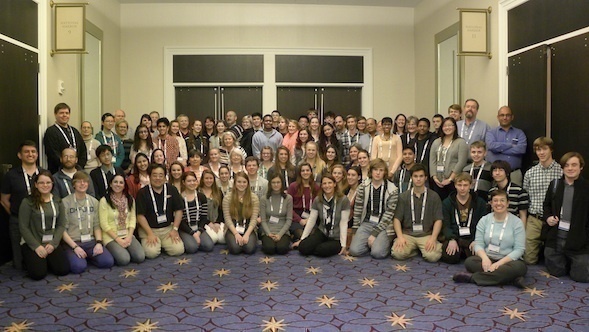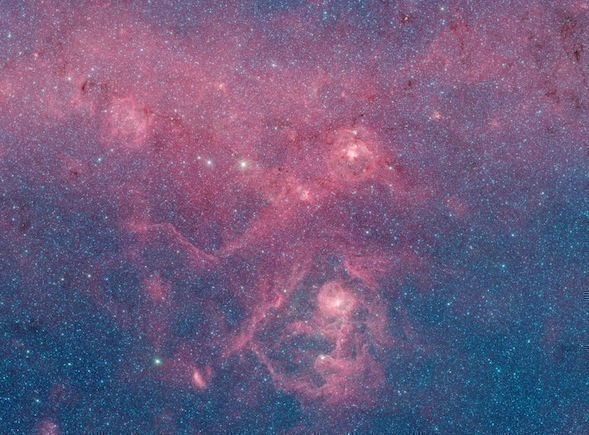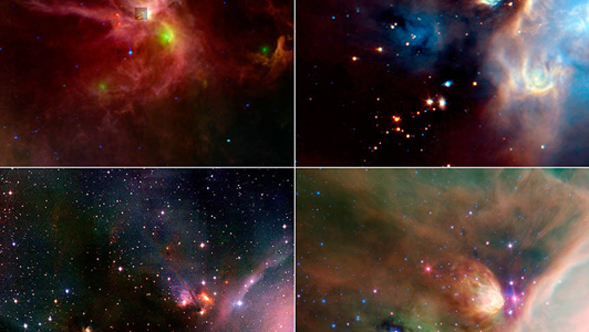
By Luisa Rebull | January 7th, 2014
How many high school teachers and kids can say that they have presented their astronomy research alongside professional astronomers at an international conference? These folks can!
The NASA/IPAC Teacher Archive Research Program (NITARP) is sending nearly 75 teachers and students to the winter 2014 meeting of the American Astronomical Society, held in National Harbor, MD, just outside Washington, DC, from Jan 5-9, 2014. NITARP partners small groups of educators with a research astronomer for a year-long authentic research project. The educators and their students from the 2013 class are presenting the results of their work over the past year, and the educators from the 2014 class are meeting their teams and getting started on their projects. Several self-funded NITARP alumni are also returning to the AAS to present work they have done after being intensively involved in the program.
NITARP has been running since 2005. A total of 87 educators from 32 states have participated or will participate in 2014. NITARP works with educators because, through them, NITARP reaches thousands of students per year with information about how science really works, what NASA does, and the wealth of astronomy data available to the public. Here are the teams that are presenting posters at the AAS meeting this week:
2013 team working with Dr. Babar Ali (NASA Herschel Science Center/IPAC):
- Melissa Booker (Robinson Secondary School, Fairfax, VA)
- Carol Ivers (Foran High School, Milford, CT)
- Margaret (Peggy) Piper (Lincoln-Way High School/Adler Planetarium, Chicago, IL – Mentor teacher for team)
- Lynn Powers (Bozeman High School, Bozeman, MT)
This team used infrared data from the Herschel Space Observatory and the Spitzer Space Telescope to investigate effects of star formation triggering mechanisms on young stars in the star-forming region NGC 281. They did not find any differences in the ages of young stellar objects on the East and West sides of the region, despite the fact that the trigger mechanism may be different between the two regions. This team also was the first NITARP team ever to require use of the computer programming language Python throughout the team; they are presenting a poster on the lessons learned from this aspect of the experience.
2013 team working with Dr. David Ciardi (NASA Exoplanet Science Institute/IPAC) and Dr. Steve Howell (NASA/Ames Research Center):
- Holly Bensel (St. Mary’s School, Medford, OR)
- Fred Donelson (Gahanna Lincoln High School, Gahanna, OH)
- Danielle Miller (University High School, Orlando, FL)
- Sally Seebode (San Mateo High School, San Mateo, CA – Mentor teacher for team)
Using Kepler Mission data from the NASA Exoplanet Archive, this team performed a blind study of 200 red giant stars previously identified as hydrogen shell burning or helium core burning. By analyzing the amplitude of the strongest period of each star, they developed a diagnostic that predicts the red giant evolutionary state with 82% accuracy.
2013 team working with Dr. Varoujan Gorjian (JPL/IPAC):
- John Blackwell (Phillips Exeter Academy, Exeter, NH – Mentor teacher for team)
- Nicole Granucci (Oxford High School, Oxford, CT)
- Theresa Paulsen (Ashland High School, Ashland, WI)
- Thomas Rutherford (Sullivan South High School, Kingsport, TN)
This team used the NASA Extragalactic Database (NED) to identify a large sample of Seyfert-type active galactic nuclei (AGN). They used optical data from the Sloan Digital Sky Survey (SDSS) and ultraviolet data from the Galaxy Evolution Explorer (GALEX) satellite to look for a correlation between the ratio of the ultraviolet (UV) and optical emission of these AGN to their UV luminosity. They find a good UV/optical correlation for a subset of the original sample.
2013 team working with Dr. Luisa Rebull (Spitzer Science Center/IPAC):
- John Gibbs (Glencoe High School, Hillsboro, OR – Mentor teacher for team)
- Wendi Laurence (Portland State University, Park City, UT)
- Robert Marshall (Carnegie Science Center, Pittsburgh, PA)
- Michael Murphy (Ravenscroft High School, Raleigh, NC)
- Laura Orr (Ukiah High School, Ukiah, OR)
- Christi Whitworth (Pisgah Astronomical Research Institute, Rosman, NC)
This team used infrared data from the Widefield Infrared Survey Explorer (WISE), combined with optical and near-infrared data from other archives and data from the literature, to look for new young stars in and around a region called BRC 38. They found several likely new young stars in this region. The 2013 educators will now go on to conduct at least 12 hours of professional development for their colleagues in their schools and communities, at the local, regional, and national levels, in print and in person.
We are announcing today that the educators starting with the NITARP class of 2014 are:
2014 team working with Dr. Varoujan Gorjian (JPL/IPAC):
- Todd Burke (Estes Park High School, Estes Park, CO)
- Linda Childs (Florida Virtual School, Orlando, FL)
- Caroline Odden (Phillips Academy, Andover, MA – Mentor teacher for team)
- David Strasburger (Noble and Greenough School, Dedham, MA)
- Kevin Tambara (Bert Lynn Middle School, Torrance, CA)
2014 team working with Dr. Luisa Rebull (Spitzer Science Center/IPAC):
- David Black (Walden School of Liberal Arts, Provo, UT)
- Jennifer Elin Deeb (Bear Creek High School, Lakewood, CO)
- John Gibbs (Glencoe High School, Hillsboro, OR – Mentor teacher for team)
- Estefania Larsen (Millard South High School, Omaha, NE)
They will present their results, with their students, at the 2015 AAS in Seattle, WA.
The Infrared Processing and Analysis Center (IPAC), based at Caltech, in Pasadena, CA, is leading this program. These teams use archival data from the Spitzer Space Telescope (part of the Spitzer Heritage Archive, SHA), the NASA/IPAC Extragalactic Database (NED), the NASA Exoplanet Archive, the NASA/IPAC Infrared Science Archive (IRSA), all of which are based at IPAC, and other NASA archive holdings. Funding comes from the NASA Astrophysics Data Program, and the other archives at IPAC.
 Remembrance of Things Past
Remembrance of Things Past
 From IRAS to Spitzer and Beyond: 30 years of Space-Based Infrared Astronomy
From IRAS to Spitzer and Beyond: 30 years of Space-Based Infrared Astronomy



